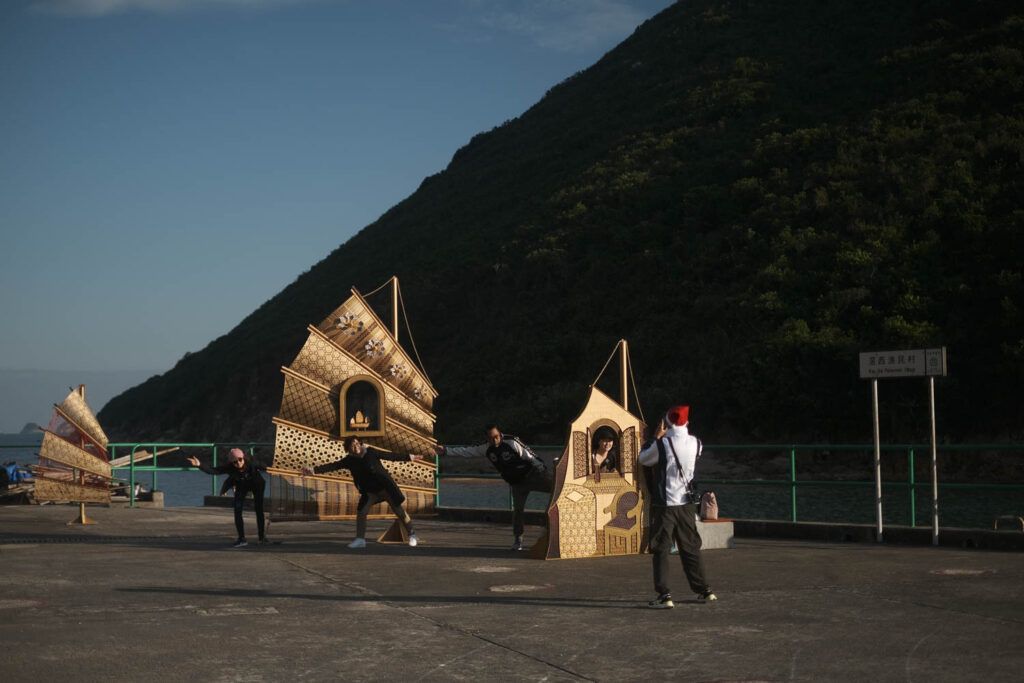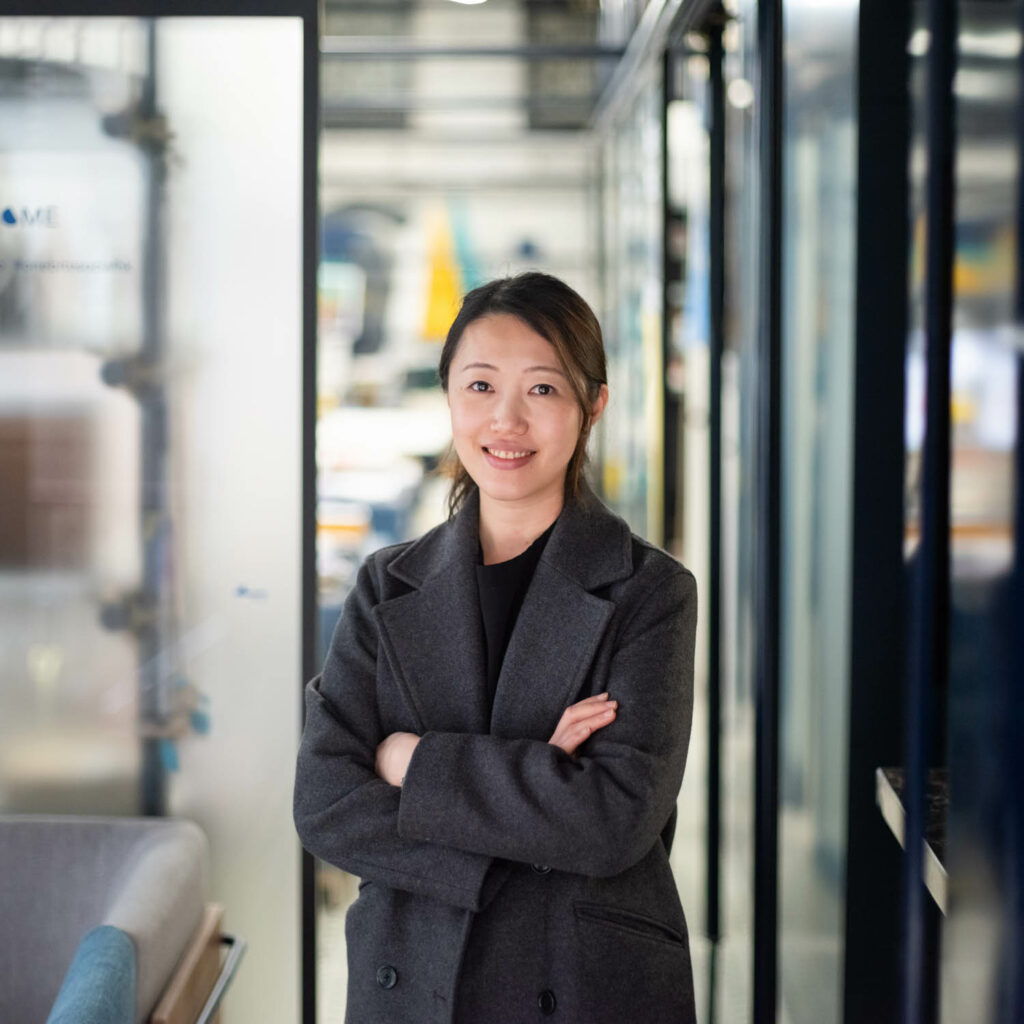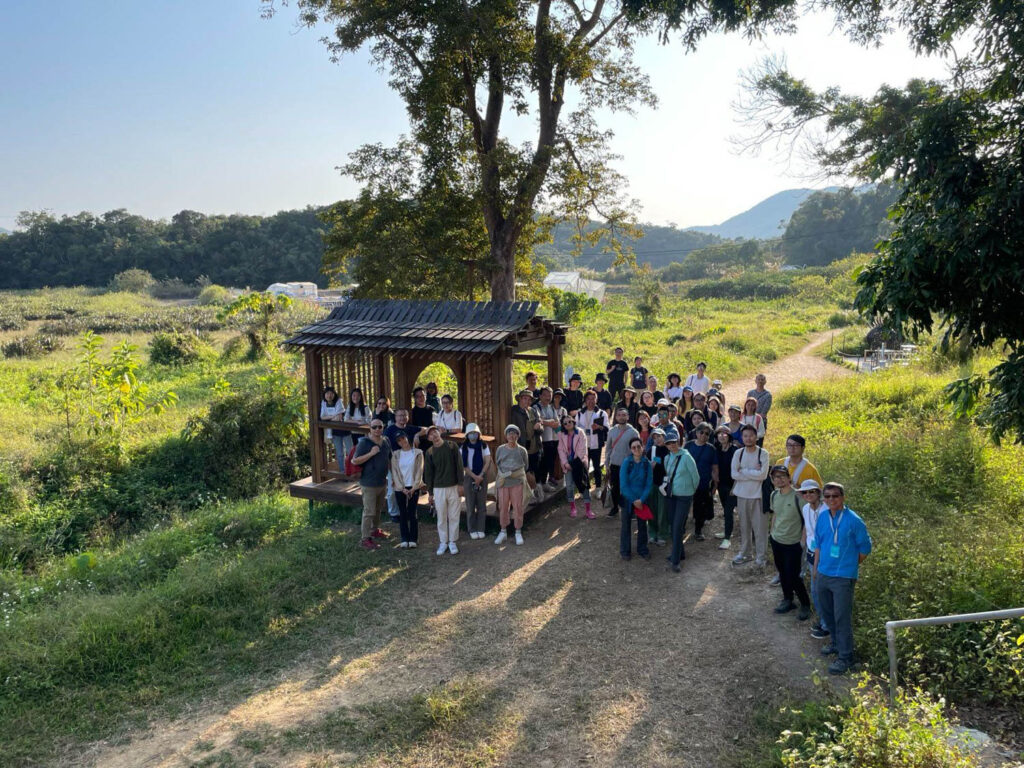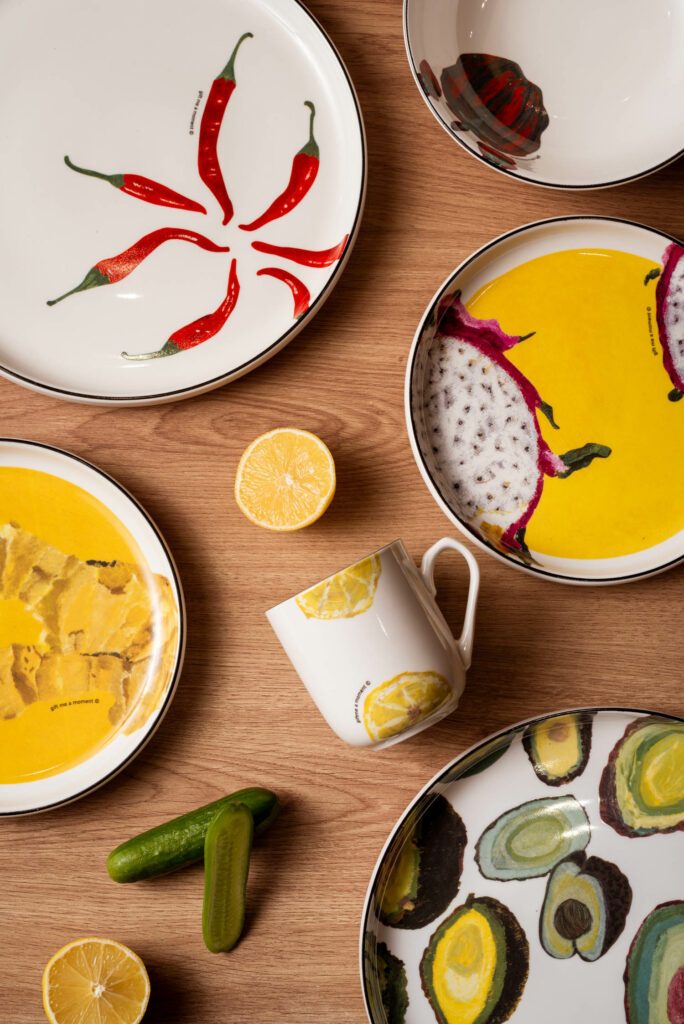
10 Questions With… One Bite Cofounder Sarah Mui
It is a cold January afternoon in Hong Kong, making the warmth of a hip studio off Queen’s Road West all the more welcoming. Occupying several floors within a traditional Chinese tong lau (tenement with retail on the ground floor), its decades-old terrazzo floor tiles have withstood the test of time. Lording over the espresso bar is Ball, one of five rescue cats; another named Strong nestles on a sofa beside a bookcase overwhelmed by books and magazines on topics ranging from urbanism to graphics. This is the workspace of One Bite, home to 35 architects, designers and planners.
Sarah Mui emerges from its depths sporting a vermillion colored toque, an exclamation point topping her all-black attire. Hand-in-hand with her husband and business partner Alan Cheung, the couple established One Bite in 2015 as a practice that marries community and design. In the past decade, the firm has worked on or curated projects for leading developers, governmental departments, and charities. While built structures and spaces are part of One Bite’s DNA, it is known more for starting conversations—refreshing when face-to-face discussions in bricks and mortar locales are increasingly rare.
As One Bite’s design director, Mui leads concept direction for the firm employing a rigorous research-based approach to every project. She reveals to Interior Design how her work combines her passion for social work and architecture; how art and design can spark meaningful dialogue; why studio life must continue outside the office; and ways to recharge when her batteries are low.

Sarah Mui Discusses Art, Design, and the Hong Kong Community

Interior Design: Why did you study architecture?
Sarah Mui: I originally wanted to be a fashion designer; my mother gave me a book on I.M. Pei and it changed my mind. Since I liked to draw and my math wasn’t bad, mom thought that architecture was a good combination of my skill set. My second choice was social work: voluntary community involvement has long been my hobby.
After I graduated from The Chinese University of Hong Kong (CUHK) in 2006, I continued my architectural studies abroad. I felt the need to see more and chose the Bartlett at University College London because that city is about design. Living in the UK taught me to embrace cultural shock and gave me a lot of insight and inspiration, including into the Brits’ particular sense of humor. I learned there is a place for whimsy in design along with its aesthetic appeal.
That was how Alan and I came up with the name One Bite in 2015: our approach is to share the experience of design one bite at a time—to savor its unique flavor. We definitely didn’t want to name the studio after ourselves. Instead, One Bite is an interesting enough name to strike an impression even with those who know nothing about design. It is humorous. Hopefully, it invites people to reach out.
ID: Why a studio with your husband?
SM: We met at CUHK; Alan was two years ahead of me. We both moved to London together: me to study and him to work. After we returned to Hong Kong, I was with a large firm for several years overseeing mostly commercial projects. I travelled all over China for different sites and found that I wasn’t interested in working only on chain brands and shopping malls. So, I took a break in 2014 to figure out what I wanted to do.
It was very natural to partner with Alan. It was tough finding a company that aligns with my passions. We had just gotten married and thought we would do our own thing for six months or so. And we are still doing it!
ID: How do you approach design decisions together?
SM: We have very different strengths. I’m the one who crafts the narrative and forms the vision for our projects. Alan executes its details in the right places at the right times; he is also an excellent project manager. I see our partnership like cooking: it takes different strengths to make a delicious meal come together.

ID: And this year you are celebrating One Bite’s 10 year anniversary?
SM: Yes, but our mission remains the same: We are still about connecting people and making places. All of us wear many hats. In 2017, we started One Bite Social to test new ideas. Last year, One Bite Strategy began as a way to help community building. And One Bite Urban is research-oriented, using data as a way to address a city’s needs.
We try to share a number of our values through these channels. We advocate refurbishment over demolition. We encourage people to make use of existing spaces. On the public side, we see ourselves as interconnectors: We work with NGOs and other stakeholders in each neighbourhood to rope in their experience—shared experiences become shared memories.
ID: One of your first significant projects was the 2019 Hong Kong portion of the Urbanism and Architecture Bi-City Biennale (UABB) at The Mills. Could you share more?
SM: We worked closely with Roger Wu, the lead curator that year. We discussed and brainstormed a lot about how to make design more approachable to the public. Compared to other shows we put on afterwards, UABB was heavily designed. All the installations were super spatially curated and participating artists all worked within consistent parameters. But the 2019 biennale’s nature was also very different from later shows. It was held in a new arts hub recently converted from a textiles factory. The space was already very cool to work within.

ID: What about the interactive exhibition “Serendipity in the Street” in 2021 at Tai Kwun?
SM: It was our third exhibition working with the revitalized cultural hub’s heritage team. Being in the same district, we see daily how public spaces in Central are appropriated. We thought: Why not consider Tai Kwun itself as a public space? It was a chance to adopt our research approach to determine the exhibition’s content. We hosted four months of engagement workshops with people who lived in the area. We audited spaces and approached folks to ask questions such as why they sat on outdoor staircases. The results of our studies yielded the prototypes for the show’s four themes.
ID: What are some community projects that stand out for you?
SM: The Hong Kong Jockey Club engaged us and Hong Kong Community Colleague to work with eight different local schools for JC Co-creating Wellbeing from 2020 to 2022. The goal was to improve the students’ wellbeing through refreshing the spaces. To get there, we liaised with teachers and students, who had a say in the final design outcome. It is a very personal approach for me to conduct workshops and research—I really like the process of doing it, and we promote the practice to our clients such as Jockey Club.
Since 2019, we have worked with New Life Psychiatric Rehabilitation Association on gift330. This branding project transforms art by people recovering from mental illness into lifestyle products: plates, water bottles and mugs. We like that the word ‘gift’ means both ‘present’ and ‘talent’, which sums up the talents of the people we help through the gifts they make. We got their art plastered onto the sides of a tram—and the artists rode around Hong Kong island on this art-clad tram at its launch. For many, it was their first tram ride. It was so rewarding to see them interact with the city this way.

ID: You just completed the second year curating Sai Kung Hoi Arts Festival?
SM: It is Hong Kong’s largest outdoor public art project to date. There are three rounds of installations over three consecutive years. Each edition with guided tours and workshops run for about two months though the installations themselves remain in situ throughout the festival’s duration. New ones were introduced during the second year for a total of 18 installations across four Sai Kung islands after two years.
For the first year, we invited artists to submit proposals; the second year, there were some sites that we opened it up for any artist to propose. This November will be our third year and includes international performing artists using the previous installations as backdrops for live shows. Since the site may be in the forest or a beach, we want to make sure the first two years’ installations won’t be blown away or wrecked after sitting out unattended for so long. We engaged some architects for submissions since we knew they would create installations that were structurally sound.
We work with a lot of local villages across remote, sparsely inhabited sites, and we got many of their elders to share their stories. For the artists, our main criteria was whether they were willing to communicate their concepts to the public—challenging, as artists tend to let their art speak for itself. The second was that they had to commit to telling their stories on site for two months. The third was to inject the findings of researchers who unearthed tales from villagers, to share them with successive generations of locals. These oral traditions became part of the art.
ID: How do you deal such a wide range of clientele?
SM: Actually, it is all about the people we work with directly, regardless of whether they are in the public or private sector. Are they people with vision? Do they want real change?
We recently began a public training program to share the community engagement methods we developed. The session drew a mix of people: students, government workers and professionals. We help them think outside the box and hopefully they can take away something useful for their own projects. It was a small group of 12 so far, and we hosted it in our studio.
There is a lot to love about Hong Kong. People here are smart and flexible. But they need to know there are always alternatives. They have choices and space to make those choices. We all need to talk more about what we want out of our cities. And then it is up to governments and developers to make that happen.


ID: What do you do outside the studio to reenergize?
SM: Alan and I integrate life with work. Sometimes we bring our three dogs into the studio. What we do takes a lot of time, hard work and commitment, but we love it.
I can always tell when I’m running low on gas. Then I go read a book or watch a film. Though I don’t read novels, everything else is fair game. I love looking at illustrations or urban design. And I love the world-building in Marvel movies. I get buzzed about our public training sessions. Talking to people energizes me. I am lucky that our work itself often recharges me.


read more
DesignWire
10 Questions With… Painter Daniel Rich
North Carolina and Berlin-based painter Daniel Rich shares the details behind his geometric interiors and what he sees inside architectural forms.
DesignWire
Behind the Mic: Get to Know Jeremiah Brent
What does Jeremiah Brent, interior designer and host of the Ideas of Order podcast, have to say about home? It turns out, quite a lot.
DesignWire
Design Icon and Hall of Famer Gaetano Pesce Dies at 84
Gaetano Pesce, a visionary designer, artist and sculptor who enchanted the world with his unique sense of materiality, has passed at 84.


